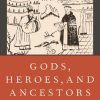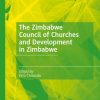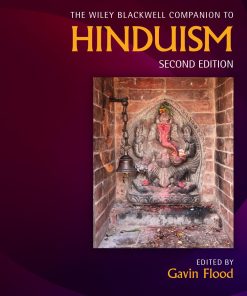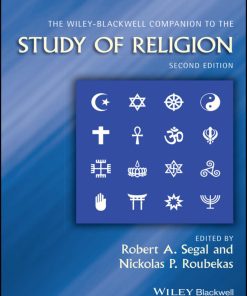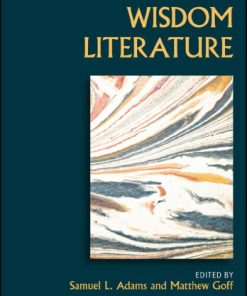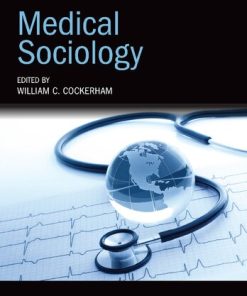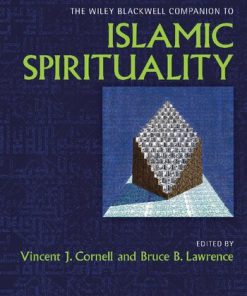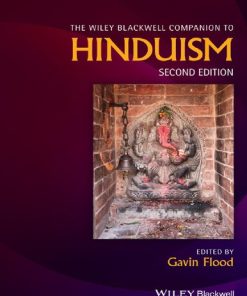The Wiley Blackwell Companion to Religion and Politics in the US 1st Edition by Barbara Mcgraw 1118528679 9781118528679
$50.00 Original price was: $50.00.$25.00Current price is: $25.00.
The Wiley Blackwell Companion to Religion and Politics in the U.S. 1st Edition by Barbara A. Mcgraw – Ebook PDF Instant Download/DeliveryISBN: 1118528679, 9781118528679
Full download The Wiley Blackwell Companion to Religion and Politics in the U.S. 1st Edition after payment.
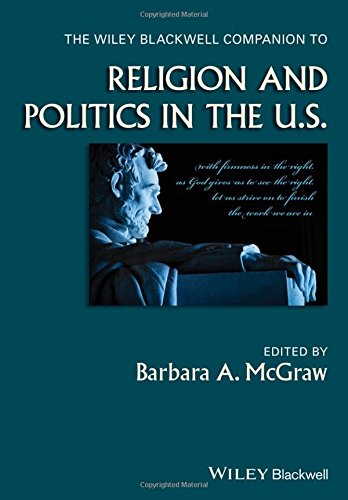
Product details:
ISBN-10 : 1118528679
ISBN-13 : 9781118528679
Author: Barbara A. Mcgraw
The Wiley Blackwell Companion to Religion and Politics in the U.S. provides a broad, inclusive, and rich range of chapters, in the study of religion and politics. Arranged in their historical context, chapters address themes of history, law, social and religious movements, policy and political theory. Broadens the parameters of this timely subject, and includes the latest work in the field Draws together newly-commissioned essays by distinguished authors that are cogent for scholars, while also being in a style that is accessible to students. Provides a balanced and inclusive approach to religion and politics in the U.S. Engages diverse perspectives from various discourses about religion and politics across the political and disciplinary spectra, while placing them in their larger historical context
The Wiley Blackwell Companion to Religion and Politics in the U.S. 1st Table of contents:
Part I: Foundations and the Founding
Introduction to Part I
CHAPTER 1: Original Nations of “Great Turtle Island” and the Genesis of the United States
A View from the Shore of Great Turtle Island (“North America”)
The Book of Genesis and the Genesis of the Theology of Domination
The Genesis of the Doctrine of Christian Discovery
Symbol, Ritual, and Imagination in the Presumed Right of Sovereignty
The Territories of Original Nations: A “Promised Land” for the United States
Johnson v. M’Intosh: The Doctrine of Discovery Becomes a Basis for US Law
Conclusion
References
CHAPTER 2: The Intellectual Foundation and Political Construction of American Religious Pluralism
Toward the Demise of the New “Old World”
Intellectual Foundation of Modern Political Construction
Political Construction of Religious Pluralism
Aftermath of the Political Construction of Religious Pluralism
Paradox of Pluralism
References
CHAPTER 3: Religion and the Foundations of Slavery in America
Religion and the Creation of Slavery in the American Colonies
Religion and Anti-Slavery in America Up to the Revolutionary Period
Conclusion
References
CHAPTER 4: Roger Williams, Native Peoples, and “Soul Liberty”
The Thoughts of Williams
“Christian Values” and Native Peoples
Conclusion
References
CHAPTER 5: Were Any of the Founders Deists?
Civic Leaders Who Publicly Embraced Deism
Civic Leaders Who Privately Embraced Deism
Other Possibilities
But Were Even a Handful of Founders Deists?
God Words?
A Representative Sample?
Acknowledgment
References
CHAPTER 6: The Heterodox Republic Part I
The Religion of Nature and of Nature’s God
Conclusion
References
CHAPTER 7: The Heterodox Republic Part II
The American Reformation
Conclusion
References
CHAPTER 8: How the Founders Agreed about Religious Freedom but Disagreed about the Separation of Church and State
The Founders’ Agreement: The Natural Right to Religious Freedom
The Founders’ Disagreement: How to Separate Church from State in Order to Protect Religious Liberty
References
CHAPTER 9: Religion and the Earliest Supreme Court Justices, 1789–1811
Religion in Biography
Natural Law As Public Law
Natural Law and the Court
Conclusion
References
Part II: Challenges to an Assumed Homogeneity
Introduction to Part II
CHAPTER 10: Millennial Groups and American Pluralism
The Millennial Imagination
Toward a Protestant Commonwealth
The Callous Side of Democracy: Separatism or Withdrawal
Mormon Withdrawal
Legacy of Religious Pluralism
References
CHAPTER 11: Religion and the Nineteenth-Century Supreme Court, 1811–78
Religion in Biography
Justice Joseph Story, Christianity, and the Law
Justice Story’s Impact on Decisions Involving Religion
Post-Story Decisions on Religion
Conclusions: The Turning Tide
References
CHAPTER 12: Native Americans, Christian Missionaries, and the Politics of the Forced School Movement
References
CHAPTER 13: Preserving the Protestant Nation
Religion and the Founding of the Nation
The Early National Period and Populist Protestantism
The First Wave of Non-Protestant Immigrants
The Classic Era of Immigration – The So-Called “Second Wave”
Conclusion: Saving the Protestant Nation
References
CHAPTER 14: New Religions and New Politics in Nineteenth-Century America
Founding Freemasons
Anti-Slavery and Workingmen’s Magic
Esoteric Communalism
The Flowering of Spiritualism
Theosophy and Nationalism
The Politics of New Thought
Metaphysical Socialism
References
CHAPTER 15: Religion and the Politics of the Women’s Movement in Nineteenth-Century America
Shifting Historiographical Paradigms
The Religious Origins of Political Feminism
Abolitionism: The Power of Agitation
Religious Dissent and Feminist Politics
The Overlapping Authorities of Church and State
Spiritualism and the Women’s Movement
The Politics of Women’s Moral Authority
Radical Feminist Theologies
A Divided Legacy
References
CHAPTER 16: Religion and Slavery in Antebellum America
The Emergence of the Antebellum Anti-Slavery Movement
Pro-Slavery Religious Thought and Race
Citing the Bible to Justify Slavery
Conclusion
References
CHAPTER 17: The Peak of American Political Religion
Lincoln’s Early Religious Views
Providentialism in the Nineteenth Century
The Second Inaugural Address: Lincoln’s Providentialism
The Second Inaugural and Reconstruction
On Lincoln’s Political Theology
References
CHAPTER 18: Completing the Constitution
Introduction: The Bill of Rights and the Fourteenth Amendment
Pre-Civil War Historical Context
Post-Civil War Historical Context and the Fourteenth Amendment
Following the Passage of the Fourteenth Amendment
Interpreting the Fourteenth Amendment
“Completing” the Constitution
Conclusion
References
CHAPTER 19: Preserving Morality in an Urban Nation
Post-Civil War Social Problems: The Gilded Age and Redemption
Temperance
Anti-Vice Campaigns
The Social Gospel and Muscular Christianity
Conclusion: The Great War and the Legacy of Progressive-Era Reform
References
Part III: Political Religion Rising, Retrenching, Resurging
Introduction to Part III
CHAPTER 20: Religion and Political Thought in the Twentieth Century
John Dewey and the Secularized Imagination
Political Liberalism and the Recovery of the Religion Question
The Return of (De-Secularized) Political Theology
At Century’s End: A Political Theology or Theological Political Theory?
References
CHAPTER 21: The Religious Left Tradition in Twentieth-Century America
Rise: 1900–1940
Disruption: 1940–1955
Revival: 1955–1980
Persistence: 1980–2000
References
CHAPTER 22: The Religious Right in the Twentieth Century
Creation
Mobilization
Reconstitution
Continuation
References
CHAPTER 23: Religion and Immigration Post-1965
Religion in American Life and Culture – the Rival Stories
The 1920 to 1965 Period: Immigration Hiatus
Social, Cultural, and Immigration Changes Post-1965
Religion in the Current Political Landscape of Immigration
Conclusion
References
CHAPTER 24: Ending the Ban on Indigenous Spiritualities
References
CHAPTER 25: The Black Church and Political Activism in Twentieth-Century America
Black Churches Engaging the Public Square
Political Engagement for Economic Progress
Political Activism for Environmental Justice
Limitations of Black Church Activism
References
CHAPTER 26: New Religious Movements and Politics in the Twentieth Century
Controversial Politically Active Groups
Groups Testing the Boundaries of Free Exercise of Religion
Groups That Provoke Social Controversy
Conclusion
References
CHAPTER 27: Women, Politics, and Religion in the Twentieth Century
The Politics of Virtue in the Early Twentieth Century
Second-Wave Feminism, Anti-Feminism, and Religion
Religion and the Question of Women’s Power
References
CHAPTER 28: Themes in the US Supreme Court’s Treatment of Religion in the Twentieth Century
Separation of Church and State
Cooperation between Sacred and Secular
Integration of Religion and Politics
Accommodation of Civil Religion
Conclusion
References
CHAPTER 29: Religion and the Rise of Environmental Politics in the Twentieth Century
Background: Religion, Nature, and Politics from First Contacts through the Nineteenth Century
Environmental Politics from the Turn of the Twentieth Century to Earth Day: The Increasing Influence of Science and the Widespread Emergence of Activism
Religion, Nature, and Politics from Earth Day to Climate Activism
Conclusion: The Contested Terrain of Religion and Environmental Politics in the Twentieth Century
References
CHAPTER 30: Religion and Realism
Wilsonianism and World War I
World War II and the Cold War
The United States and Israel
Democratic Universalism in the Post-Cold War Era
A Clash of Civilizations at the Dawn of a New Century?
Conclusion
Acknowledgment
References
Part IV: Twenty-First Century Trends and Special Topics
Introduction to Part IV
CHAPTER 31: The Politics of Moral Values
The Religious Part of the Equation
The Moral Political Symbiosis
From Symbiosis to Backlash
The Moral Religious Debate Influencing the Twenty-First Century
References
CHAPTER 32: The Religion Clauses in the Twenty-First Century
Limiting the Limits of Religious Establishment
The Limited Scope of the Free Exercise Clause
Conclusion
Acknowledgment
References
CHAPTER 33: Trending
Migration
Ministry
Media
Conclusion
References
CHAPTER 34: Contemporary Ethno-Religious Groups and Political Activism in the United States
Ethnicity and the Political Mobilization of Immigrants
Religion and the Political Mobilization of Immigrants
Methods and Data
Background to the Research
Religion and Activism: Foreign Policy
Religion and Activism: Domestic Policy
Conclusion
References
CHAPTER 35: Religious Influences on Catholic and Jewish Supreme Court Justices
Introduction
Religion Issues and the Current Supreme Court
Catholic–Jewish Differences among Elites
The Establishment Clause and Public Opinion
Explaining Catholic–Jewish Differences
The Exceptions
References
CHAPTER 36: Trends in Religion and Environmental Politics into the Twenty-First Century
Christianity and Environmental Issues in the United States
The Influence of, and Reactions to, Popular Expressions of Green Religion and Ethics
International Environmental Activities and Political Engagement in the United States
Future Scenarios: Toward a Global Ecological Civil Religion?
References
CHAPTER 37: Engaging Religion in US Foreign Affairs
The Absence of Religion
Religious Engagement during the Clinton and Bush Years
Religious Engagement during the Obama Presidency
Criticisms of Government Engagement with Religion
Establishment Clause Constraints?
Conclusion: The Promising Future
References
CHAPTER 38: America’s Missions
The “Mission” of US Foreign Policy
The “Missions” of Other Political Actors
The Future of US Foreign Policy and Religion
Conclusion
References
CHAPTER 39: Religion, State, and Democracy
Religion, State, and Democracy’s Twin Tolerations
Democratic Models of Religion and State and Their Consequences beyond the United States
Implications for US Foreign Policy-Making
Conclusion
References
CHAPTER 40: Religious Pluralism at the Crossroads
From Protestant Hegemony to Religious Pluralism
A Quiet Revolution
Religious Liberty and Conservative Christians
Conclusion
Acknowledgment
References
People also search for The Wiley Blackwell Companion to Religion and Politics in the U.S. 1st:
the wiley blackwell companion to cultural and social geography
the wiley blackwell companion to ancient israel
the wiley blackwell companion to african religions
the wiley blackwell companion to theology and qualitative research
the wiley blackwell companion to religion and social justice
Tags: The Wiley, Blackwell Companion, Religion, Politics, Barbara Mcgraw
You may also like…
Religion & Spirituality - Religious Studies
Wiley-Blackwell Companion to the Study of Religion Nickolas P. Roubekas
Religion & Spirituality - Bible
Medicine - Others
The Wiley Blackwell Companion to Medical Sociology 1st Edition William C. Cockerham
Religion & Spirituality - Religious Studies
Religion & Spirituality - Islam
The Wiley Blackwell Concise Companion to the Hadith 1st Daniel W. Brown
Uncategorized
Religion & Spirituality - Religious Studies
Religion & Spirituality - Hinduism


